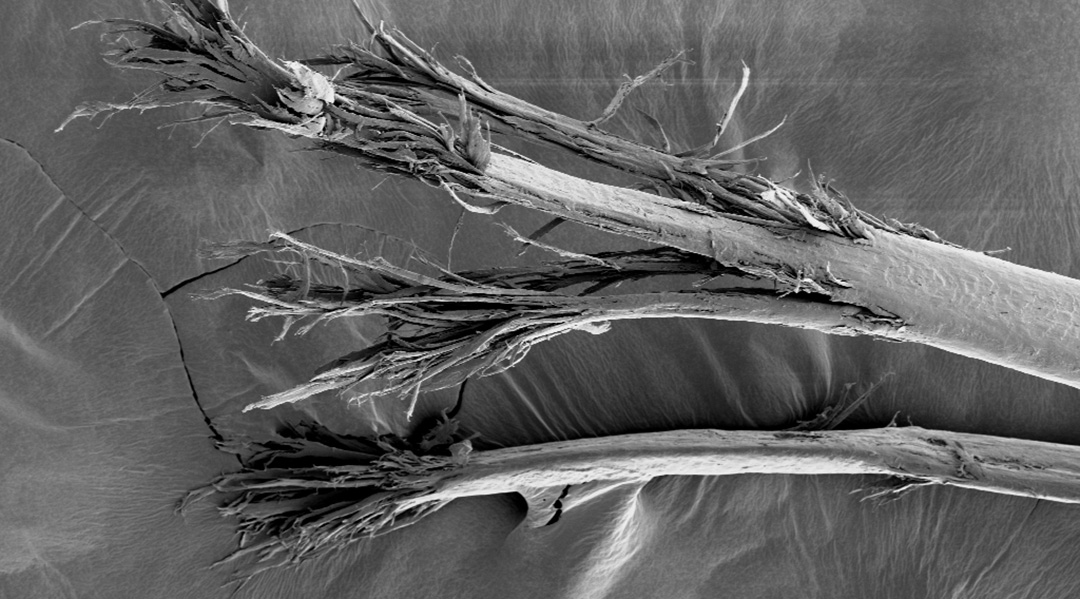Researchers are splitting hairs when it comes to a centuries-old problem: split-ends.
Hair is susceptible to damage from wear and tear, and this damage typically occurs at the tips since that is where the oldest and most fragile strands of our hair reside.
Though a ubiquitous problem, how and why this happens is still unclear. To get to the bottom of this, the team of materials scientists created a new device that simulates some of the styling practices believed to cause them. The study was initiated by L’Oreal, the popular manufacturer of hair products.
“It is a very fundamental scientific study,” said David Taylor, now professor emeritus at Trinity College Dublin, and lead author on the study. “[L’Oreal] said we just want you to tell us more about what hair is, how it works as a material, and what you think causes it to split.”
It was not overly surprising for Taylor to get this call, as he’s built a career investigating how things break. His early endeavors began with building materials, like steel and concrete, and later moved to biological materials like bone, ligaments, and muscle. Understanding how materials fail has allowed his group to consult on how to avoid breakage or improve their integrity.
Hair was a new material for Taylor, but the first step in any investigation into how something breaks is understanding more about its fundamental structure.
What makes hair strong also makes it knotty
Hair is mostly made of a protein called keratin and is anisotropic. “[This means] it’s got very different properties in different directions,” explained Taylor.
If hair is pulled lengthwise, it is incredibly strong. “Stronger than steel,” he added. But when pulled sideways direction, it’s much weaker.
This is because hair is made from the layering of many fibers of keratin. “Nature starts from the bottom up and does what we now call additive manufacturing, like 3D printing,” he said. This design, while lending strength, does mean it can be split more easily lengthwise.
“[Another] thing is that keratin, and this is very unusual, has what we call a very high strain to failure,” he said. “[When pulled from the end,] it’s quite stiff and hard to pull, and then when you get to a certain amount of stress, it becomes easier to pull and then it gets longer and longer and longer,” said Taylor. This, he says, is the reason hair tangles and forms knots.
It was hypothesized roughly 50 years ago that knots in hair create high amounts of stress and cracking at the point where two hairs are looped around one another. Combing out the knots pushes this force along the length of the hair, to the end, bringing the split with it.
However, no one had yet attempted to test or quantify this theory. “So that’s where we came in,” said Taylor.
Removing knots but splitting ends
To replicate the forces applied onto hair from combing out knots, Taylor and his colleagues devised a simple test they called the moving loop fatigue test. This involves looping two strands of hair like a link in chain.
One of the hairs is weighted at both ends so it pulls down on the loop while the ends of the other are held and pulled up and down, creating friction and pressure at the point in the loop where the hairs are crossed.
Remarkably, this motion split the hair in two. “Suddenly, instead of having one hair in your hands you’ve got two hairs because the hair is totally split down its length,” said Taylor.
The team tested the hair of two of their own members, one who regularly had split ends and and another who didn’t, which they labeled low and high quality, respectively. In the moving loop fatigue test, the low quality hair required less pulls to split. They also tested hair that had been bleached and found it also split more quickly during the moving loop test.
Damage done
These results further confirm what others in the cosmetic and haircare field have long suspected: split ends occur when we do things to our hair like bleaching, curling, and even combing, especially while wet.
“Because we do all these things to our hair, that weakens certain chemical bonds. For example, if you wet your hair, you break some of the hydrogen bonds and your hair is weaker,” said Taylor.
There are also cysteine bonds, which involve sulfor atoms in the keratin molecule. “If you apply bleach, these cysteine bonds break,” said Taylor. Once broken, he believes the anisotropy of the hair increases as these bonds connect layers of keratin molecules, leading to easier splitting and split ends.
“So if you want to be free from hair damage, just don’t bleach your hair, don’t change its color and don’t comb it,” he concluded with a laugh.
However, hair styling is something intrinsic to our culture and personalities. “It’s part of us,” acknowledged Taylor. “For thousands of years, human beings have always done these things; we’ve been putting on makeup, we’ve pierced body parts, we changed our hair, and it’s not optional really.”
The next goal for the Taylor group is higher quality images of the damage incurred during the moving loop test. “We’re going to put damaged and broken specimens into a synchrotron particle accelerator,” he said.
Here, extremely high power X-rays can reveal how the hair is splitting down to the micron level. “To find out exactly what parts of the microstructure are separating and failing when we get that split is obviously going to be useful in trying to design products that prevent it,” Taylor said.
Reference: David Taylor, et al., The biomechanics of splitting hairs, Interface Focus (2024). DOI: 10.1098/rsfs.2023.0063
Feature image: David Taylor et al.













